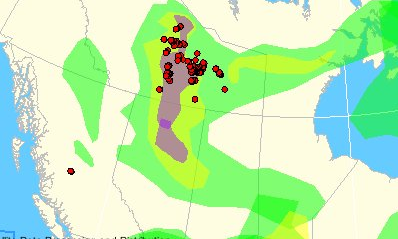Fires in Canada’s Northwest Territories have burned six times more hectares than the 25-year average, according to data from the Canadian Interagency Fire Center.
There are 224 fires burning to-date in the Northwest Territories–that’s almost double the 25-year average of 156. Data shows that the fires have consumed 872,374 hectares (that’s more than 2 million acres).
Check out the Northwest Territories fire management’s Facebook page for some stunning photos of the Birch Creek Complex fires. (Climate Central did a great article on the history of fires in the area and pointed out some of this data, read it here.)
This summer Western Canada is seeing one of its most active fire seasons in more than a decade. More than 150 fires were burning in the western province of British Columbia as of last week.
While the far-west Yukon territory is seeing a below-average fire season, several fires in the Northwest Territories are pushing heavy smoke into BC and Alberta. Last week, smoke from Canadian fires obscured skylines on the American east coast.

Portions of south-central BC have been issued extreme fire danger warnings for Sunday.
Here are some updates on a couple of the fires we’ve been following:
- The Smith Creek Fire in West Kelowna is now 30 percent contained, and officials have lifted some evacuation orders for certain residential neighborhoods, local media reports.
- The Mount McAllister fire northeastern BC had burned 16,000 hectares (almost 40,000 acres) as of Sunday morning, and is still uncontained. Last week the fire forced the evacuation of the entire town of Hudson’s Hope — the evacuation was later lifted, and no homes have been destroyed.


The Crown fire modelling site and the research conducted there has indeed added incredibly to our understanding of fire behaviour, adequate clearances for radiant heat both for structures and humans, and yes of course the groundbreaking work on the effects on fire shelters. Unfortunately that site is only a few miles south of Fire ZF-020 and only one or two burning periods from being run over. Resources are stretched thin up there but it would be a damn shame to lose those plots. Let’s all hope it’s on somebody’s radar – somebody who can make a difference.
In 1997 – 1999, a bunch of folks from around the world went into the NWT to intentionally set crown fires and measure the rates of spread against computer models. Lots of other work went on as well, including looking at the effects of radiant heat on different fire shelters, and on PPE. Jim Kautz from MTDC designed cameras that would survive inside the fires, and got some incredible footage, some that is included in the “Fire Shelter” video used in RT-130.
The NWT has vast acreages of uninhabitated land, and fire has visited this country many times in the earlier centuries – should be some great moose and caribou habitat in the coming years!
Check out the “International Crown Fire Modeling Experiment” video on YouTube at http://www.youtube.com/watch?v=d2pzaog0oVU. Great video footage that will help you appreciate the intensity of the flat land fires in the Jack pine fuel type.